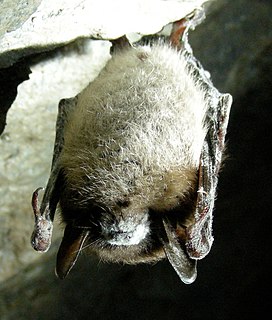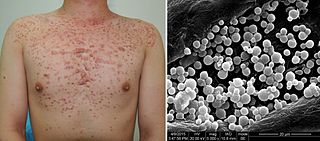
Malassezia is a genus of fungi. Malassezia is naturally found on the skin surfaces of many animals, including humans. In occasional opportunistic infections, some species can cause hypopigmentation or hyperpigmentation on the trunk and other locations in humans. Allergy tests for this fungus are available.

The big brown bat is a species of vesper bat distributed widely throughout North America, the Caribbean, and the northern portion of South America. It was first described as a species in 1796. Compared to other microbats, the big brown bat is relatively large, weighing 15–26 g (0.53–0.92 oz) and possessing a wingspan of 32.5–35 cm (12.8–13.8 in).

Natterer's bat is a European vespertilionid bat with pale wings. It has brown fur tending to greyish-white on its underside. It is found across most of the continent of Europe, parts of the Near East and North Africa. It feeds on insects and other invertebrates which it catches on the wing or pursues on the ground.

Malassezia furfur is a species of yeast that is naturally found on the skin surfaces of humans and some other mammals. It is associated with a variety of dermatological conditions caused by fungal infections, notably seborrhoeic dermatitis and tinea versicolor. As an opportunistic pathogen, it has further been associated with dandruff, malassezia folliculitis, pityriasis versicolor (alba), and malassezia intertrigo, as well as catheter-related fungemia and pneumonia in patients receiving hematopoietic transplants. The fungus can also affect other animals, including dogs.

Geotrichum candidum is a fungus which is a member of the human microbiome, notably associated with skin, sputum and feces where it occurs in 25–30% of specimens. It is common in soil and has been isolated from soil collected around the world, in all continents.

Rafinesque's big-eared bat, sometimes known as the southeastern big-eared bat, is a species of vesper bat native to the southeastern United States.

The southwestern myotis is a species of vesper bat. It is found in Guatemala, Mexico, and in Arizona and New Mexico in the United States.

Brandt's bat is a species of vesper bat in the family Vespertilionidae. It is native throughout most of Europe and parts of Asia. It is known for its high life expectancy relative to its body size, approximately twice that of humans and holds the record for the oldest bat; in 2005, one individual was discovered in a cave in Siberia that had been banded in 1964, making the bat at least 41 years old.

The western small-footed bat, also known as the western small-footed myotis, is a species of vesper bat native to North America.

Findley's myotis is a species of vesper bat. It is found only on the Tres Marías Islands off the west coast of Mexico.

The little brown bat or little brown myotis is an endangered species of mouse-eared microbat found in North America. It has a small body size and glossy brown fur. It is similar in appearance to several other mouse-eared bats, including the Indiana bat, northern long-eared bat, and Arizona myotis, to which it is closely related. Despite its name, the little brown bat is not closely related to the big brown bat, which belongs to a different genus.

White-nose syndrome (WNS) is a fungal disease in North American bats which has resulted in the dramatic decrease of the bat population in the United States and Canada, reportedly killing millions as of 2018. The condition is named for a distinctive fungal growth around the muzzles and on the wings of hibernating bats. It was first identified from a February 2006 photo taken in a cave located in Schoharie County, New York. The syndrome has rapidly spread since then, however. In early 2018, it was identified in 33 U.S. states and seven Canadian provinces; plus the fungus, albeit sans syndrome, had been found in three additional states. Most cases are in the eastern half of both countries, but in March 2016, it was confirmed in a little brown bat in Washington state. In 2019, evidence of the fungus was detected in California for the first time, although no affected bats were found.

Malassezia folliculitis or Pityrosporum folliculitis, is a skin condition caused by infection by Malassezia yeast.

Pseudogymnoascus destructans is a psychrophilic (cold-loving) fungus that causes white-nose syndrome (WNS), a fatal disease that has devastated bat populations in parts of the United States and Canada. Unlike species of Geomyces, P. destructans forms asymmetrically curved conidia. Pseudogymnoascus destructans grows very slowly on artificial media and cannot grow at temperatures above 20 °C. It can grow around 4 °C to 20 °C, which encompasses the temperatures found in winter bat hibernacula. Phylogenic evaluation has revealed this organism should be reclassified under the family Pseudeurotiaceae, changing its name to Pseudogymnoascus destructans.

Escalera's bat is a European bat in the genus Myotis, found in Spain, Portugal, and far southern France.

The California myotis is a species of vesper bat. It is found in British Columbia in Canada, Guatemala, Mexico, and in the western United States, including California.
Malassezia equina is a fungus first isolated in horses, which can cause opportunistic infections in animals. Its type strain is MA146=CBS 9969. This species will not grow without any lipid supplementation. It grows slowly and forms small colonies. In the lab, colonies will not grow at temperatures of 40 °C, differing from M. sympodialis-related species, such M. dermatis and M. nana, which can grow at this temperature. Malassezia caprae cells are ovoidal.
Malassezia caprae is a fungus first isolated in goats, which can cause opportunistic infections in animals. Its type strain is MA383=CBS 10434. This species will not grow without any lipid supplementation. It grows slowly and forms small colonies. In the lab, colonies will not grow at temperatures of 40 °C, differing from M. sympodialis-related species, such M. dermatis and M. nana, which can grow at this temperature. Malassezia caprae cells are ellipsoidal to more or less spherical.
Malassezia pachydermatis is a zoophilic yeast in the division Basidiomycota. It was first isolated in 1925 by Fred Weidman, and has been named pachydermatis Greek for "thick-skin" after the original sample taken from an Indian rhinoceros with severe exfoliative dermatitis. Within the genus Malassezia, M. pachydermatis is most closely related to the species M. furfur. A commensal fungus, it can be found within the microflora of healthy mammals such as humans, cats and dogs, However, it is capable of acting as an opportunistic pathogen under special circumstances and has been seen to cause skin and ear infections, most often occurring in canines.
Malassezia sympodialis is a species in the genus Malassezia. It is characterized by a pronounced lipophily, unilateral, percurrent or sympodial budding and an irregular, corrugated cell wall ultrastructure. It is one of the most common species found on the skin of healthy and diseased individuals. It is considered to be part of the skin's normal human microbiota and begins to colonize the skin of humans shortly after birth. Malassezia sympodialis, often has a symbiotic or commensal relationship with its host, but it can act as a pathogen causing a number of different skin diseases, such as atopic dermatitis.














